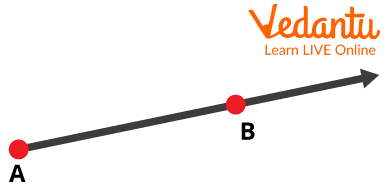




How to Solve Problems Using the Normal Form of a Line
Lines are the basic geometry in mathematics. We have many types of lines as we will learn later in this chapter. As we see every polygon is a set of line segments. And a line is a set of points. Here we will learn how points decide a line. And how we use it in our daily graph calculations.
What Is Line:
A line is a 1D figure. Which has length but not width. To understand a line we can say that a line is a collection of so many points. And every point is in the opposite direction. Every line has at least two fixed points as a minimum. The line is infinite in both directions. It doesn't have any limits.
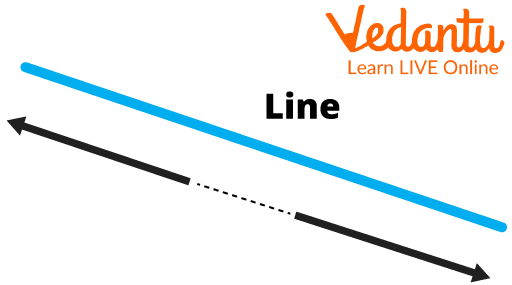
Line
Then there is another form of a line which is called a Line segment. It is called a line segment. It is just a part of the line. It has its limits in both directions.
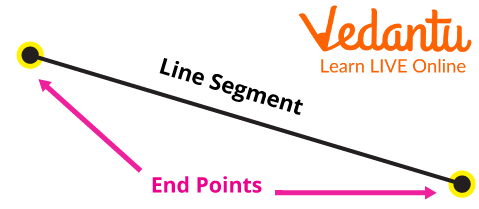
Line Segment
The last form of a line is Ray. It is a line that passes through two fixed points in which one point of this line is fixed and the other one is limitless.
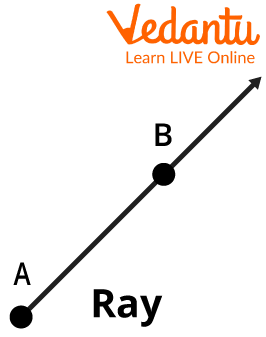
Ray
Now, Look at the difference between these all.
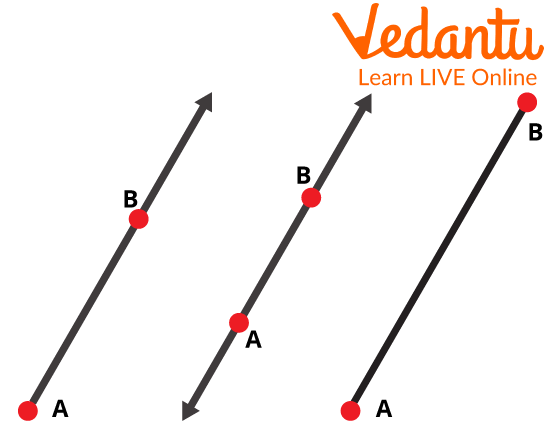
Ray, Line, Segment
The 1st one is a “Ray”.
2nd is a “Line”.
The 3rd one is the “Line segment”.
General Equation Of a Straight Line:
It is also known as “The general equation” of a line. We mostly derive it from the help of coordinate geometry.
The equation is:
\[y = mx + c\]
“m” is the gradient.
For example:
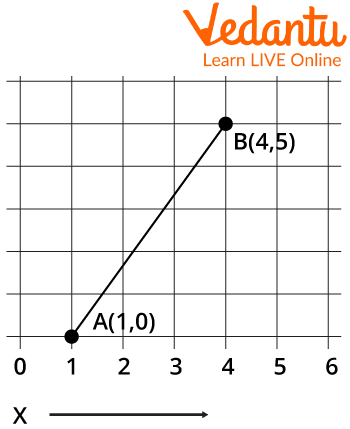
Line which has Coordinate A(1,0) and B(4, 5)
We can write its equation as :
Finding slope(m) = \[\frac{{5 - 0}}{{4 - 1}} = \frac{5}{3}\]
Substituting m into the equation:- y = mx + c
\[\Rightarrow y = \frac{5}{3}x + c\]
Now put any 1 coordinate value in this equation and find the value of C,
\[ \Rightarrow 0 = \frac{5}{3} \times 1 + c\]
\[ \Rightarrow - c = \frac{5}{3}\]
The equation we get is –
\[y = \frac{5}{3}x - \frac{5}{3} \Rightarrow 3y = 5x - 5;\]
The Equation Of Straight Line In Normal Form:
Now let’s get to the normal form of line which is mostly used in geometry.
Here we have an example diagram of normal form derivation.
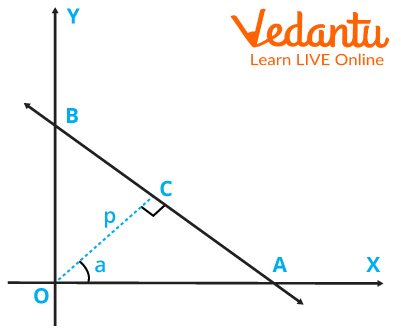
A Line Crossing through point A on the X-axis and B on the Y-axis, P is the Perpendicular on AB from the Origin
here, Triangle AOB
P stands for Perpendicular distance from Origin to line AB.
stands for the angle between the perpendicular and X-axis.
Its Equation is:-
\[x{\rm{ }}cos{\rm{ \theta}} + y{\rm{}}sin{\rm{ \theta}} = {\rm{ }}p\] Normal Form Formula
Polar Equation Of Straight Line:
It is called slope-intercept form. As we use a line’s slope and its intercept,
Look we have a general form of a line: ax + by = c
so, to use this equation in the polar form we transform it as \[y{\rm{ }} = {\rm{ }}r{\rm{ }}sin\theta \] and \[x{\rm{ }} = {\rm{ }}r{\rm{ }}cos\theta \].
The polar equation is –
\[\;{\bf{r}}({\bf{a}}{\rm{ }}{\bf{cos}}\theta + {\rm{ }}{\bf{b}}{\rm{ }}{\bf{sin}}\theta ) = {\rm{ }}{\bf{c}}\]
We can write polar forms as –
\[r\,\sin \theta + mr\,\,\cos \theta + c\]
Solved Examples
Question1: The given figure is an example of –
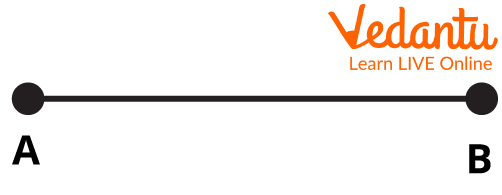
Line Segment
Perpendicular
Parallel lines
Ray
Ans: Line segment
Question2: Identify, which is the straight line –
Ans: 3 is the only one extending on both sides to infinity.
Solved Questions
Question 1: what is the general equation of line?
My = x + c
Y = mx + b
Sin x = 2 + ay
A = bx + c
[Hint: Y= mx + c]
Conclusion:
Till now we have learned about lines and the general form of it which is y = mx+c; we now know how to use a line in coordinate. And can derive any line equation from a given coordinate. Let’s have some practice on these concepts now.
FAQs on Normal Form of a Line: Definition, Formula & Applications
1. What is the normal form of a line's equation?
The equation of a straight line in its normal form is given by x cos α + y sin α = p. This format is particularly useful as it defines a line based on two key parameters: the length of the perpendicular from the origin to the line and the angle this perpendicular makes with the x-axis. This is a fundamental concept in coordinate geometry for Class 11 students as per the CBSE 2025-26 syllabus.
2. What do the parameters 'p' and 'α' represent in the normal form of a line?
In the normal form equation x cos α + y sin α = p, the two parameters have distinct geometric meanings:
- 'p' represents the length of the normal (perpendicular) drawn from the origin (0,0) to the line. By convention, this distance 'p' is always taken as positive.
- 'α' (alpha) is the angle that this perpendicular line segment makes with the positive direction of the x-axis, measured in the anti-clockwise direction.
3. How do you convert the general equation of a line to its normal form?
To convert the general equation Ax + By + C = 0 to the normal form (x cos α + y sin α = p), you follow these steps:
1. Move the constant term to the other side: Ax + By = -C.
2. Divide the entire equation by √(A² + B²) to normalise it. The sign of the square root is chosen to make the constant term on the right-hand side, p, positive.
3. The resulting equation, (A/√(A²+B²))x + (B/√(A²+B²))y = -C/√(A²+B²), is in the normal form, where cos α = A/√(A²+B²), sin α = B/√(A²+B²), and p = |-C/√(A²+B²)|.
4. Can you provide a practical example of finding a line's equation using the normal form?
Certainly. Suppose you need to find the equation of a line where the perpendicular from the origin has a length of 4 units and this perpendicular makes an angle of 135° with the positive x-axis.
- Here, the given parameters are p = 4 and α = 135°.
- The normal form is x cos α + y sin α = p.
- Substitute the values: x cos(135°) + y sin(135°) = 4.
- Since cos(135°) = -1/√2 and sin(135°) = 1/√2, the equation is x(-1/√2) + y(1/√2) = 4, which simplifies to -x + y = 4√2 or x - y + 4√2 = 0.
5. What is the derivation for the normal form of a line, x cos α + y sin α = p?
Consider a line L. Let the perpendicular from the origin O(0,0) to the line L be OM, with length 'p'. This perpendicular OM makes an angle 'α' with the positive x-axis. The coordinates of point M on the line L are therefore (p cos α, p sin α). The slope of the normal OM is tan α. Since line L is perpendicular to OM, its slope will be the negative reciprocal, which is -1/tan α = -cot α. Using the point-slope form for line L with point M and the derived slope, we get:
y - p sin α = (-cos α / sin α)(x - p cos α)
y sin α - p sin²α = -x cos α + p cos²α
Rearranging the terms gives:
x cos α + y sin α = p(sin²α + cos²α)
Since sin²α + cos²α = 1, we get the final equation: x cos α + y sin α = p.
6. When is it better to use the normal form instead of the slope-intercept form (y = mx + c)?
The normal form is the most advantageous and direct method when a problem explicitly provides information about the line's perpendicular distance from the origin and the orientation (angle) of that perpendicular. While the slope-intercept form (y = mx + c) is ideal when the slope and y-intercept are known, the normal form simplifies problems related to tangents, reflections, and shortest distances from the origin, which are common in higher-level geometry and physics applications.
7. Why can't the normal form of a line represent a line passing through the origin?
The normal form, x cos α + y sin α = p, fundamentally cannot represent a line passing through the origin. This is due to the definition of the parameter 'p', which is the length of the perpendicular from the origin to the line. For any line that passes through the origin, this perpendicular distance is zero (p=0). The standard definition and application of the normal form are for cases where p > 0, defining lines that do not pass through the origin.
8. What is the difference between a 'normal to a curve' and the 'normal form of a line'?
This is a common point of confusion for students. The two concepts are distinct:
- A normal to a curve is a specific line that is perpendicular to the tangent of the curve at a particular point. This concept is primarily studied in calculus and is about the relationship between a line and a curve.
- The normal form of a line is a specific way of writing the equation for a straight line (x cos α + y sin α = p). It describes the line itself based on its properties relative to the origin, not relative to another curve.

























